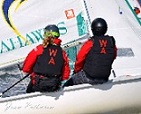The Science of Sailing - (Penn State SC200 course)
Recently I have discovered a new hobby of mine at Penn State- the sailing club. I was walking through the involvement fair last week, and I was convinced by one of the members of the club to sign up. I have never sailed before, until this past Sunday. While I was giving sailing a try, my skipper (the person who controls the main sail of the boat as well as steers the boat) told me that sailing is all about the science of finding out where to put your sails in order to achieve the highest velocity and the cleanest turns. This got me thinking, perhaps if I know the science behind sailing, I’ll be able to become a better sailor.
First, the basics of sailing. There are typically two people on a sailboat, the skipper and the crew. The skipper,  who is at the back of the boat, does the main job, as I already mentioned in the previous paragraph. The other position is the “crew” or the one that manages the smaller sail, called the jib. The basic job of a sailboat sailor- whether competitive or noncompetitive- is to go with the wind in precisely the right way in order to generate the most velocity.
Guillaume Florent explains in his article “Sailing: From Work to Fun” that the sail must develop a synchronization with the wind in order to move at maximum speed. This means that the sail must remain convex, so that the flow of wind around the sail does not detach and begin to increase the pressure put on the sail. If a lot of pressure is put on the sail, the speed of the boat decreases significantly. So, what is the perfect position to steer your boat to most effectively reach your destination? Of course, it depends on the direction of the wind, but there are plenty of options.
There are multiple ways to steer the boat, and some are more effective than others. The different positions are called points of sail. All in all, there are 6 points of sail, which are listed below.
the points of sail
Starting at the top of the circle, there is the point of sail called “in irons.” This is the area in which it is completely impossible to sail. The boat is going into the wind, and just like if a person tried to walk straight into a wind tunnel, the boat would be blown backwards if this type of point of sail was used.
Going down the circle, the next point is called “close hauled.” When sailing in this position, the boat is on a 45 degree angle. The boat will go upwind in a diagonal direction. The sailors must position their sails so that they are close to the boat, in order for the wind to form a channel through which it is possible for the boat to pass through. If the channel is not formed, then the boat is at risk of turning back into “in irons” and capsizing.
Next, there is “close reach.” The sail is let out a bit more, and the boat moves in the direction of 2 o’clock. This position is the most ideal, because it is one of the more efficient ways to sail.
Fourth, there is “beam reach.” Beam reach puts the boat at a 90 degree angle. This point of sail is incredibly ideal, because it is the fastest one. However, the boat’s direction would simply be straight, so unless you are on a broad and open area with no true destination, using “beam reach” will be rare.
After that comes broad reach. When it comes to “broad reach,” the boat is reaching out at 100 degrees to 140 degrees. The sails should be positioned about three quarters of the way out, and the wind should hit the sails in a way the makes them convex enough to push forward in a position that almost qualifies as going downwind.
Finally, the last point of sail is called running. This is when the boat is going completely downwind. During with this tactic, the boat sails will be completely parallel to the sailboat itself.
I never would have thought that I would come to Penn State and join the sailing club, but I’m happy that I did. Obviously, sailing is complex, and there is a lot of physics that goes into it. Most sailors probably do not think about the science behind their sport while they are sailing, but now that I understand it, I think that it will improve my skill in my newfound hobby of sailing.
High School Sailing


